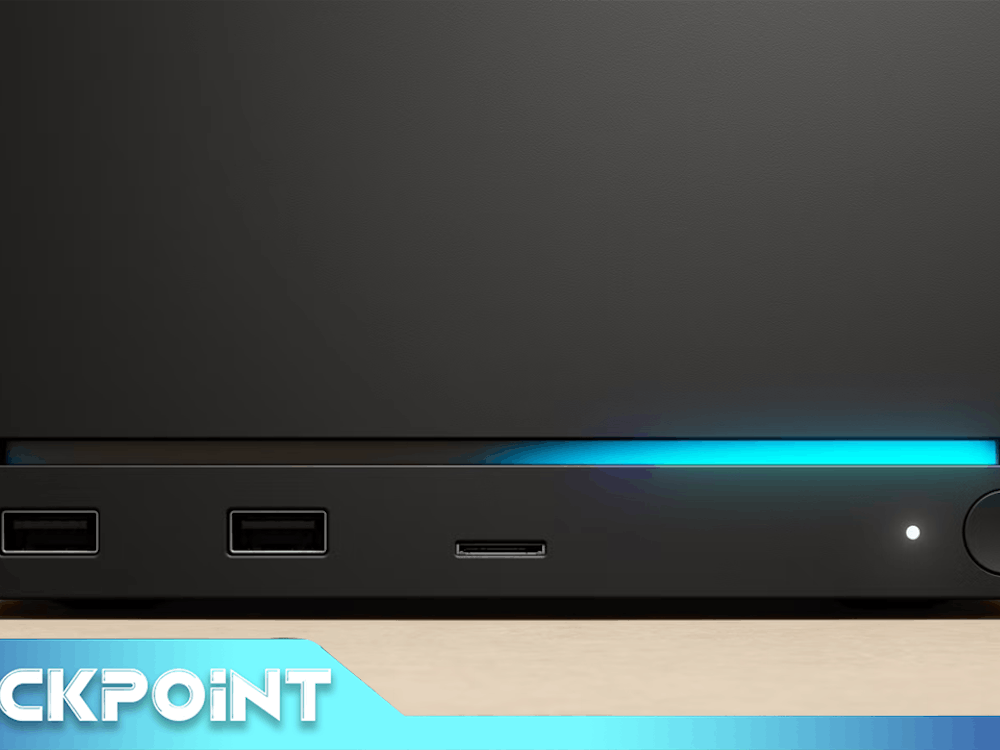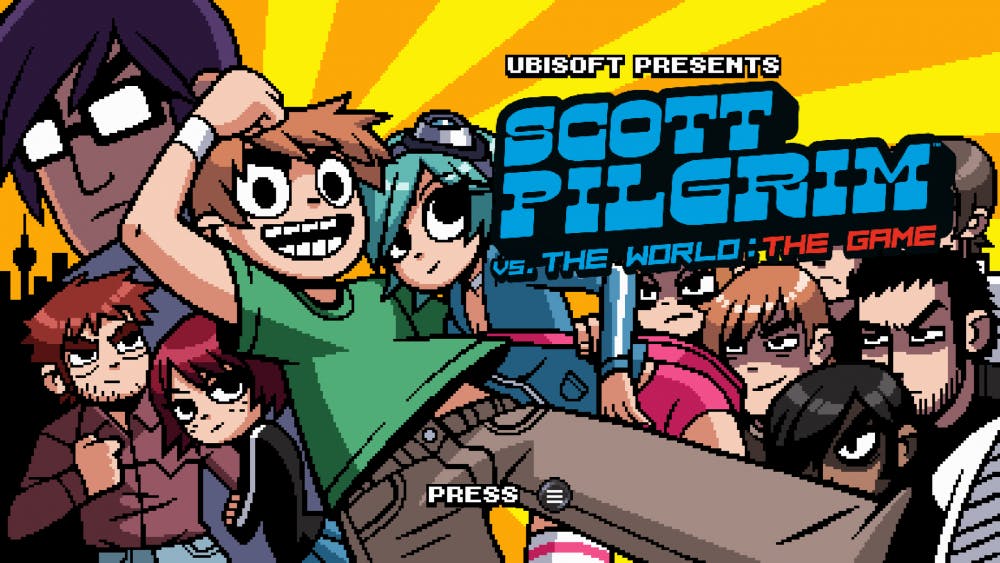By Blake Chapman Disclaimer: This review is for the Xbox One version of the game, conducted on an Xbox One X, and all gameplay images were captured in-game. The Scott Pilgrim series of graphic novels are possibly the only books I have ever read that I resonate with on a truly vulnerable personal level. Nowadays, stories about indie darlings learning about maturity are a dime a dozen. Still, you will be hard-pressed to find a saga more timeless than the story of this 23-year-old loser bassist falling head over heels for the girl of his literal dreams. The dialogue and development shared between Scott, Ramona, Knives, Kim, and the rest of this incredible cast warms the reader up inside. Their human struggles extend beyond the backdrop of whimsical video game-style combat and a distinctive art style. Scott’s journey is one of personal accountability and responsibility, while Ramona’s is about self-acceptance and appreciation; it is a beautiful journey that I recommend to anyone on the cusp of adulthood. I became a member of that fandom far before I ever entered my formative late teenage years. The movie adaptation’s electrifying action encouraged me to purchase the full box set of the original Bryan Lee O’Malley comics and I have been smitten ever since. Whenever I face a crossroads in my life, I revisit one or both of those projects and extract a new slice of wisdom about my path forward. There is one entry in the collection of Scott Pilgrim related content that I have not ever been able to fully indulge in: the video game. Scott Pilgrim Vs. The World: The Game was a movie tie-in originally developed and published by Ubisoft in 2010. Since then, it has amassed a cult following, which only became more ravenous after the title was delisted from digital storefronts and became unavailable to purchase and even more difficult to play. After half a decade and in commemoration of the 10th anniversary of the film’s release, Ubisoft has put together a complete edition of the original game, including additional downloadable content. Scott Pilgrim: Complete Edition is a great piece of video game history, but below the surface, it is a disheartening experience built on nothing more than rose-colored nostalgia.
Gameplay that makes me want to beat up my controller
 While movie tie-in games are usually watered-down versions of the cinematic product,
Scott Pilgrim: Complete Edition
diverges into uncharted albeit understandable territory by squeezing into what remains of the arcade brawler genre typically referred to as “beat ‘em ups.” Even if this creative idea makes sense based upon the gaming roots tightly weaved into the source material, what makes or breaks an arcade brawler is the combat. Sadly, it is in this area that the
Scott Pilgrim
game falters the most. No matter how long you spend leveling up the roster of six characters, they all eventually unlock the same set of combos. Without their ingenious 16-bit designs, everyone from Scott to Ramona feels like carbon copies of each other, and if you intend to play this title alone, get ready to adopt a whole new meaning of the word “frustration.”
This is definitely a game meant to be played with a full party of other players, and the difficulty curve while playing solo is incredibly against you. On higher difficulties, it takes multiple tries to make it through even half of any given level, let alone defeating the final boss. That repetition is debilitating, and any semblance of satisfaction you get from beating down thugs with a plethora of interesting moves is erased beyond the easiest story mode setting. It is challenging and comes with a great deal of satisfaction, but playing this game alone is just plain irritating.
While movie tie-in games are usually watered-down versions of the cinematic product,
Scott Pilgrim: Complete Edition
diverges into uncharted albeit understandable territory by squeezing into what remains of the arcade brawler genre typically referred to as “beat ‘em ups.” Even if this creative idea makes sense based upon the gaming roots tightly weaved into the source material, what makes or breaks an arcade brawler is the combat. Sadly, it is in this area that the
Scott Pilgrim
game falters the most. No matter how long you spend leveling up the roster of six characters, they all eventually unlock the same set of combos. Without their ingenious 16-bit designs, everyone from Scott to Ramona feels like carbon copies of each other, and if you intend to play this title alone, get ready to adopt a whole new meaning of the word “frustration.”
This is definitely a game meant to be played with a full party of other players, and the difficulty curve while playing solo is incredibly against you. On higher difficulties, it takes multiple tries to make it through even half of any given level, let alone defeating the final boss. That repetition is debilitating, and any semblance of satisfaction you get from beating down thugs with a plethora of interesting moves is erased beyond the easiest story mode setting. It is challenging and comes with a great deal of satisfaction, but playing this game alone is just plain irritating.
Incomparable design expected of the series
 What makes the original
Scott Pilgrim
graphic novel and the Edgar Wright movie so unforgettable is how the phenomenal style of the former effortlessly melds into the screenwriting and direction of the latter. The video game continues this standard in the best of ways. For one, the artistry of this title more than makes up for the sometimes sour gameplay. The sprites of every hero and villain pop out from each corner of the screen with incredibly vibrant colors and nostalgic arcade-style animation that completes a delectable feast for the eyes. New levels craft personalities through style alone that go well beyond any generic gimmick. Every frame of
Scott Pilgrim: Complete Edition
simply works as a piece of exquisite retro artwork, setting it apart from the movie and graphic novel in a unique way.
Secondly, the original soundtrack from Anamanaguchi is possibly one of the greatest ever made for a video game. Chip-tune beats can become dull if not done authentically, but every piece of music, from the sounds of shopping at Dee’s Tex-Mex to the synth riffs of a pulse-pounding boss battle, synergizes with the rest of the experience while standing firmly on its own.
Finally, much like its ancestors, the game runs on an overworld-based level design reminiscent of the Super Nintendo era. While there are not that many, each offers new and interesting mechanics beyond an eye-catching setting. From traveling through the snowy streets of Toronto beating up thugs, to jumping through a movie set filled with traps from an
Indiana Jones
film, and even fighting ninjas on top of a high-speed tram before crashing into a Japanese hibachi grill, each setting meshes incredibly well in this wacky story of a dude fighting his new girlfriend’s scorned former lovers.
Despite that, the level design does not always hit the mark on a mechanical level. There are shops available at every level where you can replenish health and increase stats, but their placement is hit or miss analogous to the world’s actual conclusion. Additionally, there are no items available to replenish lives, so if you get killed three times over while fighting Todd Ingram or Roxy Richter that means you are headed all the way back to the start of what has already become a laborious gameplay loop. While other brawlers make that cycle work well and allow you to learn more each time through,
Scott Pilgrim: Complete Edition
suffers instead of gains here due to all the aforementioned problems.
What makes the original
Scott Pilgrim
graphic novel and the Edgar Wright movie so unforgettable is how the phenomenal style of the former effortlessly melds into the screenwriting and direction of the latter. The video game continues this standard in the best of ways. For one, the artistry of this title more than makes up for the sometimes sour gameplay. The sprites of every hero and villain pop out from each corner of the screen with incredibly vibrant colors and nostalgic arcade-style animation that completes a delectable feast for the eyes. New levels craft personalities through style alone that go well beyond any generic gimmick. Every frame of
Scott Pilgrim: Complete Edition
simply works as a piece of exquisite retro artwork, setting it apart from the movie and graphic novel in a unique way.
Secondly, the original soundtrack from Anamanaguchi is possibly one of the greatest ever made for a video game. Chip-tune beats can become dull if not done authentically, but every piece of music, from the sounds of shopping at Dee’s Tex-Mex to the synth riffs of a pulse-pounding boss battle, synergizes with the rest of the experience while standing firmly on its own.
Finally, much like its ancestors, the game runs on an overworld-based level design reminiscent of the Super Nintendo era. While there are not that many, each offers new and interesting mechanics beyond an eye-catching setting. From traveling through the snowy streets of Toronto beating up thugs, to jumping through a movie set filled with traps from an
Indiana Jones
film, and even fighting ninjas on top of a high-speed tram before crashing into a Japanese hibachi grill, each setting meshes incredibly well in this wacky story of a dude fighting his new girlfriend’s scorned former lovers.
Despite that, the level design does not always hit the mark on a mechanical level. There are shops available at every level where you can replenish health and increase stats, but their placement is hit or miss analogous to the world’s actual conclusion. Additionally, there are no items available to replenish lives, so if you get killed three times over while fighting Todd Ingram or Roxy Richter that means you are headed all the way back to the start of what has already become a laborious gameplay loop. While other brawlers make that cycle work well and allow you to learn more each time through,
Scott Pilgrim: Complete Edition
suffers instead of gains here due to all the aforementioned problems.
A complete edition that does not feel complete
 With every video game rerelease, the developers usually package the original game with all the downloadable content and extras that were sold following the initial launch date.
Scott Pilgrim: Complete Edition
is no different but falters based not on the amount of new content but the quality of those add-ons. The two DLCs released for the original game included two new characters (Scott’s heartbroken former girlfriend Knives Chau and his gay roommate Wallace Wells) and a few extra gameplay modes (boss rush, battle royale, dodgeball, and survival horror).
Knives and Wallace are great additions to the cast aesthetically for starters, but after playing as them for only a few hours, it becomes apparent that that is all they are good for. They do not have any extra skills or abilities that make them exceptional for veterans or newcomers aside from some different animations for their basic movesets. Playing as either of them unlocks an alternate ending to the story, but after hours of cycling through the same locations and combat encounters, the payoff is far from worth it. As for the additional gameplay modes, they are not something to write home about. Survival horror and boss rush are fun for practicing combos and strategies, but the rest are uninspired and frankly boring after only a couple of rounds of play.
After rediscovering
Scott Pilgrim Vs. The World: The Game
through the complete edition, I can not deny this is an experience defined by what is missing rather than what is present. The ability to play with A.I. companions, reworks of characters to match different play styles or proficiency levels, or perfection of level lengths so that completing the game feels more like an evening on the couch instead of a weekend-long affair are all nonexistent. If they were here, it would elevate this rerelease to heights that even the original never reached. Unfortunately, Ubisoft did not seem to care that much about a game that this legion of fans would not let them forget for the last decade.
Delisted Games
With every video game rerelease, the developers usually package the original game with all the downloadable content and extras that were sold following the initial launch date.
Scott Pilgrim: Complete Edition
is no different but falters based not on the amount of new content but the quality of those add-ons. The two DLCs released for the original game included two new characters (Scott’s heartbroken former girlfriend Knives Chau and his gay roommate Wallace Wells) and a few extra gameplay modes (boss rush, battle royale, dodgeball, and survival horror).
Knives and Wallace are great additions to the cast aesthetically for starters, but after playing as them for only a few hours, it becomes apparent that that is all they are good for. They do not have any extra skills or abilities that make them exceptional for veterans or newcomers aside from some different animations for their basic movesets. Playing as either of them unlocks an alternate ending to the story, but after hours of cycling through the same locations and combat encounters, the payoff is far from worth it. As for the additional gameplay modes, they are not something to write home about. Survival horror and boss rush are fun for practicing combos and strategies, but the rest are uninspired and frankly boring after only a couple of rounds of play.
After rediscovering
Scott Pilgrim Vs. The World: The Game
through the complete edition, I can not deny this is an experience defined by what is missing rather than what is present. The ability to play with A.I. companions, reworks of characters to match different play styles or proficiency levels, or perfection of level lengths so that completing the game feels more like an evening on the couch instead of a weekend-long affair are all nonexistent. If they were here, it would elevate this rerelease to heights that even the original never reached. Unfortunately, Ubisoft did not seem to care that much about a game that this legion of fans would not let them forget for the last decade.
Delisted Games



















